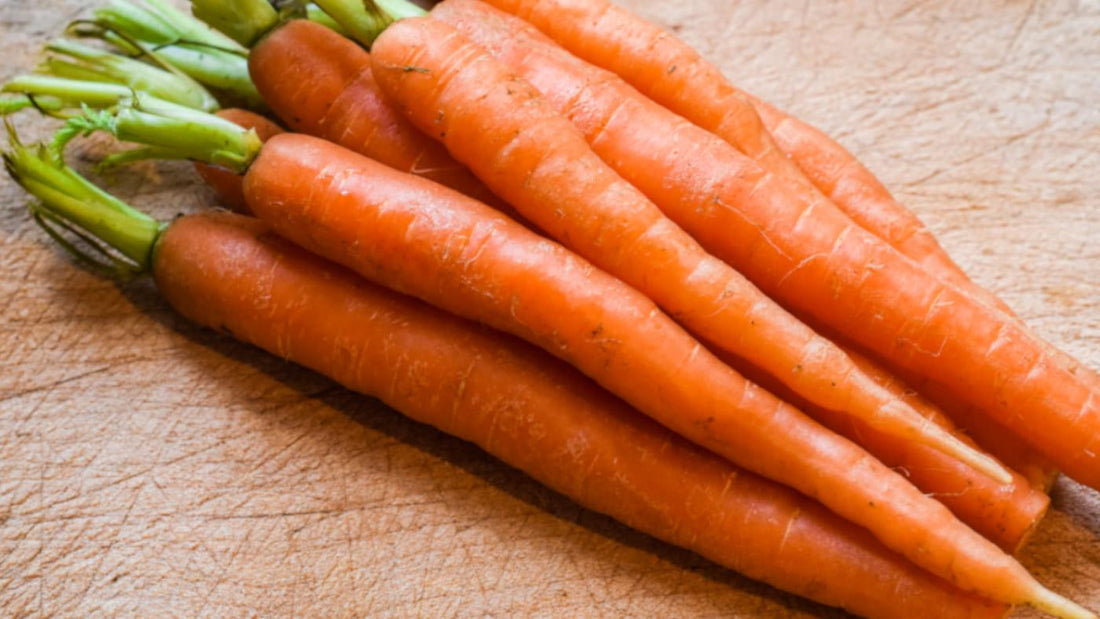Statistics show that the carrot is one of the most consumed, and highly rated, vegetables in the United States — falling short only of corn and potatoes. In fact, the average US adult eats about 12 pounds of carrots every year. That includes both fresh, frozen, and canned carrots.
To put that into perspective, every year US adults only eat about 8.3 pounds of bell peppers, 5.1 pounds of broccoli, and 3 pounds of spinach.
So what is it about this vegetable that makes it so popular?
One of the reasons why carrots are such a common food is that it lends itself to a giant range of recipes. Carrots are found in baby foods, salads, stews, snacks, cakes, and so much more, meaning that no matter the meal, eating carrots is always an option.
Besides the great versatility of their flavor, carrots are also common because of how good for you they are. This superfood is packed with nutrients such as vitamin A, antioxidants, fibers, potassium, and carotenoids. They’re essential for cell growth, and heart, lung, and kidney function, and their sweet flavor makes them a favorite vegetable among kids.
There are a lot of reasons to love carrots, and Americans aren’t the only ones who know this. Carrots are popular all around the world. In fact, the US is only the 3rd largest producer of carrots, falling short of China and Russia. In the US, about 80% of all carrot production takes place in California.
A Brief History of Carrots

Carrots weren’t always popular in the Americas — carrots are indigenous only to Western Asia, Europe, and North Africa. The most diverse species of carrots grow in these parts of the world, even today, and have grown there since before ancient human history. By the trading networks, multiple species of carrots were spread across the known world.
It wasn’t until the exploration and colonization of the Americas in the 15th and 16th centuries that carrots were brought across the Atlantic.
Since then, the carrot grew in popularity throughout America, initially as a feed for livestock, and eventually as staple in American cuisine.
The Top Health Benefits of Carrots

Carrots Improve Eye Health
This superfood is known for being rich in beta-carotene, a powerful antioxidant that your body turns into vitamin A. Beta-carotene reduces the risk of developing cancer, cataracts, dry eyes, and other eye health issues. It can also improve your night vision.
Carrots are so packed full of beta-carotene that just ½ a cup of carrots fulfills 73% of your daily vitamin A requirement. Almost all yellow, orange, and leafy green foods contain a significant amount of beta-carotene, however carrots are probably the most famous source of it — carotene was named after the carrot after all.
Carrots Support Heart Health
Carrots are a good source of both potassium and fiber — two nutrients that your heart needs to properly function. Both potassium and fiber can be used to lower high blood pressure, which is a key factor in heart attacks, strokes, aneurysms, and heart failure.
Potassium relaxes blood vessel walls, lowering blood pressure and reducing the risk of heart disease, stroke, and other heart issues. Fiber lowers blood pressure by cleaning out the arteries and preventing plaque buildup. It’s also key to maintaining a healthy weight.
When you introduce more carrots into your diet, there’s no doubt that your heart will thank you.
Carrots Strengthen Your Bones
½ a cup of carrots contains 2% of your daily calcium needs, and 9% of your daily vitamin K needs, making this vegetable a great tool for improving bone density and overall health.
Calcium promotes strong bones especially in children and adolescents but continues to help bones into adulthood by preventing brittle bone disease. Calcium also reduces the chances of breaking bones.
Vitamin K works in a similar way as calcium by increasing bone density and reducing the risk of bone fracture. However, besides improving bone health, vitamin K is also necessary for thickening blood, protecting collagen and skin health, and even preventing premature hair loss.
Buying Carrots: What to Look For

When you go to the farmers market or grocery store to buy your carrots, there are a few things you can look out for to make sure you’re getting the best quality for your money.
The best quality carrots will be firm and smooth. Their color, whether orange, purple, yellow, or red, should be vibrant. Beta-carotenes are what give carrots their color, so the brighter the color, the more nutrients that carrot is sure to have.
Avoid carrots past their prime. These carrots will be dried out, cracked, and rubbery. Overall, they really don’t lend themselves well to recipes, and won’t give you great results in the kitchen.
If you’re after sweet carrots, the thicker the better. A carrot’s sugars are concentrated in its core. Since thicker carrots have a thicker core, they’re sweeter than their thinner counterparts, and will have a richer flavor.
You could also simply buy yellow carrots. These carrots are notably sweeter than red and purple carrots, and have a milder flavor than orange carrots. They’re most commonly roasted, glazed, and put into soups.
For a richer, earthier flavor, orange carrots should be your go-to. For a very subtle radishy flavor, try purple carrots.
However, while there are many color varieties of carrots, the truth is, they all practically taste the same. Despite their very subtle flavor differences, a carrot is a carrot.

Once you’ve picked out your carrots, store them in the refrigerator until you’re ready to use them. They’ll usually last for around 3 to 4 weeks. But if you want to preserve them for longer, try wrapping them in a moist kitchen towel. The liquid from the towel may keep the carrots moist and fresh in the refrigerator for 1 to 2 additional weeks.
If your carrots came with the green tops still attached, make sure to remove them before storing in the refrigerator, as the tops pull moisture from the root — causing the carrot to dry out and wilt.
Cooking With Carrots

The subtle yet sweet flavor of a carrot makes this superfood the perfect ingredient for a surprisingly wide range of recipes. Carrots work great as a side, a main, a salad topping, a juice, and anything in between. From savory to sweet, carrots can do it all!
Of course, carrots are a great health food — we know that — but they’re also used to make one of the most classic desserts in American cuisine. Yes, I’m talking about carrot cake!
Carrot cake is one dessert you can eat without having to feel guilty. Despite being a mound of sugary sweet goodness, carrot cake still contains all the nutrients of carrots. But don’t stop at cake — carrots also make great muffins, cupcakes, cookies, and brownies!
More savory recipes that require carrots include stews, carrot soups, and salads. However, carrots are most commonly found as a side dish. Roasted, glazed, boiled, fried, and raw carrots find their way onto dinner tables everywhere from pubs and diners to five-star restaurants.

An article about carrots wouldn’t be complete without mentioning carrot juice. Perhaps one of the most popular of vegetable juices, carrot juice is a quick and delicious and nutritious way to add color to your day.
Try mixing your carrot juice with pineapple or orange juice for a more interesting flavor composition.

